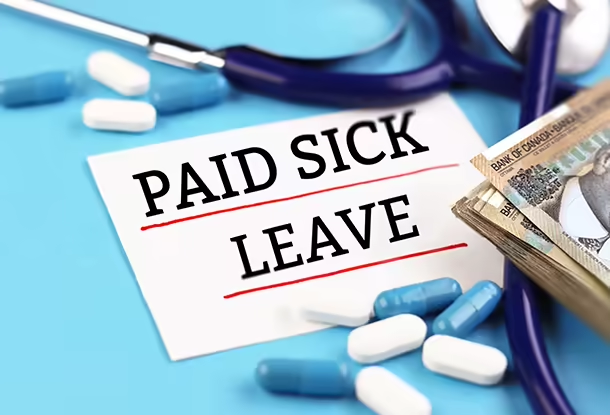`Paid leave appears to have the support that crosses party lines,` said Robin Shea, an attorney at Winston-Constangy, Salems Brooks, Smith & Prophete. `The most challenging aspect of paid leave appears to be determining how to pay for it, rather than the concept itself. This appears to be the primary reason why Congress has failed to pass a federal paid-leave scheme `for the commercial sector.
Over the last few decades, social protection programs have been developed to help people cope with the effects of economic downturns and personal misfortunes. The importance of social health protection as a human right that protects the economic output of a healthy workforce and acts as a social and economic stabilizer in times of crisis has been stressed.
Paid sick leave is especially important during times of crisis when many employees are afraid of being fired or discriminated against if they go to work sick. Indeed, the lack of paid sick days requires ill workers to choose between caring for their health and risking losing their employment. Many people would be unable to work if they did not have access to social health protection, such as paid sick leave.
Paid sick leave: What is the difference between paid sick leave and unpaid sick leave?
Paid sick leave, included in social health benefits, consists of two parts: time off work due to illness and monetary benefits to replace wages while on leave due to illness. As a result, paid sick leave is defined as compensated working days lost due to a worker's condition.
Paid sick leave is designed to protect a worker's job status and income during a period of illness or injury by providing health and financial benefits. The main argument for paid sick leave is that labour should not jeopardize one's health and that illness should not result in a loss of money or employment. From a medical standpoint, it enables employees to:
- Access to timely medical care and the ability to follow treatment recommendations;
- Recover more rapidly;
- Reduce the health impact on day-to-day functioning;
- Prevent the development of more severe illnesses;
- Reduce the transmission of diseases to the workplace and community.
As a result, paid sick leave helps to improve health outcomes and productivity by allowing people to recuperate faster. It also addresses income security and protects against financial difficulties caused by illness. It is necessary to receive health care services. It is a tool against workplace discrimination because it ensures employment and financial security.
Paid sick leave is a portion of a worker's compensation package, similar to employer-sponsored health insurance; in effect, it boosts the hourly rate for actual hours worked by paying for a specific number of non-work hours. On the other hand, paid sick leave gives employees the freedom to attend to personal health issues and family duties as they see fit (within the constraints of the number of paid sick days available). Suppose workers use paid sick leave to balance work and family obligations. In that case, it may boost worker reliability and productivity and lower the risk of being fired or laid off. On the other hand, workers are more likely to view paid sick leave as an economic and noneconomic advantage and are less likely to use it.
There is little direct evidence of a link between paid sick leave and job security, and what data there is cant be applied to all workers. Several descriptive studies demonstrate that parents who do not have paid sick or vacation leave find it challenging to balance family and work obligations, particularly during illness (Heymann, 2000; Seccombe & Hoffman, 2007). Pavalko and Henderson (2006) discover a marginally significant positive difference in the chance of continuing in the labour force associated with access to paid sick or vacation leave in a sample of women starting a spell of caring for an ill or disabled family member. Finally, Baughman et al. (2003) discover that flexible sick leave reduces employee turnover in a sample of companies, but only after the company gives the benefit.
Paid sick leave is a concept that has been around for a long time
Various ILO Conventions, legislation, concepts, and techniques describe a comprehensive concept of social health protection that includes paid sick leave, focusing on universal access to health care and financial protection in the event of illness. In this context, financial protection refers to compensation for economic losses resulting from decreased productivity and the cessation or reduction of earnings due to illness. Sick leave and related income replacement are an important part of the compensation package.
- ILO Convention 102 (Minimum Criteria)5 on Social Security, which establishes minimum social security standards and is seen as enshrining an internationally agreed definition of the idea of social security. It says that sickness benefits must cover the inability to work due to a morbid condition resulting in a loss of earnings.
The ILO Convention 130, which was adopted subsequently, suggests a slightly greater standard of benefits.
- The ILOs Decent Work Agenda identifies work of acceptable quality that offers basic security, among other things.
- The ILO and WHO-led Social Protection Floor 8 project, launched as part of the One UN response to the economic and financial crisis, calls for governments to provide appropriate social protection for all citizens through fundamental social guarantees. This covers a set of basic cash and in-kind social transfers to ensure a minimal level of income security. Universal access to necessary health care and economic support for individuals with insufficient income and income security are two of the ten key components.
Paid sick leave is frequently linked to existing sickness, disability, or other programs, demonstrating a significant link to the overall structure and financing of social (health) protection schemes in countries. Paid sick leave can be funded in principle by taxes collected by the government as part of public social expenditure and provided by public authorities; contributions or payroll taxes – with or without ceilings – under mandatory social health protection schemes as stipulated by legislation and operated by semi-public insurance funds; and contributions or payroll taxes – with or without ceilings – under mandatory social health protection schemes as stipulated by legislation and operated by semi-public insurance funds. Employers and employees could split the contributions.
Risk-based rates for private insurance coverage may be required. Private insurances provide monetary benefits in a loss of earnings, but individual workers are not covered.
Sick Leave
What Is Sick Leave and How Does It Work?
Sick leave is time off from work that many firms allow for employees who have been injured or are ill. Employees may take sick leave for a variety of reasons, including:
- Infectious and contagious diseases.
- Injuries or diseases that make it difficult for a person to accomplish their job
- Depression, worry, and stress are examples of mental diseases. (these may cause an individual to not do their work to the best of their ability)
- Appointments with doctors
- Chronic medical diseases that necessitate frequent medical attention or rest
- Hospitalizations
- Conditions associated with pregnancy and delivery
Some firms now allow employees to take advantage of sick leave to care for sick family members. (if they are the primary caregiver to that sick member… i.e. a spouse, child, or parent).
In Zimbabwe, sick leave is governed by the Labour Act (28:01), specifically Section 14. Sick leave is awarded to an employee who cannot work due to illness, injury, or medical treatment (which is not the result of the employee's failure to take reasonable precautions). Only a duly registered medical practitioner can grant such sick leave.
An employee is entitled to 90 days of paid sick leave per year (before the employer can consider medical termination). However, suppose an employee's condition is such that he or she cannot be fit for duty again after using up the maximum 90 accumulated days in a year. In that case, an employer may terminate the employee's employment.
What is the Process of Taking Sick Leave?
Sick leave is handled differently by different companies. Setting up a clear sick leave policy and placing it in your employee handbook ensures that leaders, managers, and employees all have the same expectations about how sick leave works at your company.
The following should be included in your policy:
- Who is eligible for sick time: Is it solely for full-time employees, or does it also cover part-time and temporary workers? How long must people work for your company before they qualify?
- How is sick leave compensated? Unless a contract or collective bargaining agreement states otherwise, employers who provide paid sick leave normally pay the employees a regular pay rate, excluding tips, overtime, holiday pay, and other premium pay rates.
- Which of the following reasons are valid justifications for taking sick leave: Consider the reasons listed above, as well as whether or not caring for a sick family member counts.
- When an employee needs to use sick leave, how should they notify their employer: through their supervisor, HR, or both? Is a phone call or an email for sick leave required?
- What questions should and should not be asked of the absent employee: Employers have the right to inquire about the broad cause for the employee's sickness absence, but they must be careful not to violate privacy regulations or get personal information. Employees should be informed that they may be asked:
- When do they plan to return?
- Is it possible to reach them while they are on sick leave?
- What tasks must be completed while they are away?
- Whether or not a doctor's letter is necessary: Some businesses, especially during longer absences, require returning employees to have a healthcare provider confirm that they were ill and are now able to return to work. Make it clear how many days an employee can be away from work before this rule takes effect.
Sick leave (sometimes known as paid sick days or sick pay) is paid time off from work that employees can utilize to stay home and care for their health needs. Because sick leave is designed for health-related causes, it varies from paid vacation time or time off work to dealing with personal concerns. A mental health day or time away from work to attend a scheduled doctor's visit are examples of sick leave. Menstrual leave is another paid time off for medical reasons; however, it is not always available.
Related: 11 Reasons why employees fake sick leave
Employees who are in good health are more productive. If your company does not provide sick days, many employees will choose to work rather than stay at home to avoid losing their salary. But why should businesses offer it in the first place? It's easy to believe that not paying employees when they aren't working is better for its bottom line. On the other hand, offering sick leave is beneficial to both employers and employees.
Paid sick leave has been shown to reduce employee turnover, boost productivity, and reduce disease spread in the workplace and community. Paying employees when they cannot work due to illness consumes funds that could otherwise be used for other purposes, such as increased profits or other benefits. Furthermore, there is concern that providing sick days will encourage employees to pretend to be ill. Therefore living the whole matter at a debatable stage.
This article was written by Trish Makiwa, a consultant at Industrial Psychology Consultants. She can be contacted at trish@ipcconsultants.com



